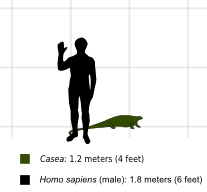
Casea
Encyclopedia
Casea is an extinct genus of pelycosaur synapsid which was about 1.2 metres (3.9 ft) long, slightly smaller than the otherwise very similar Caseoides
. Casea was one of the first terrestrial herbivores, sharing its world with animals such as Dimetrodon
and Eryops
.
 Casea had a heavy, rotund, body and a small skull
Casea had a heavy, rotund, body and a small skull
. Its rib cage was greatly expanded, presumably to make space for a large, plant-fermening gut. Like other caseids, it lacked teeth in its lower jaw, and had blunt teeth in the upper jaw. These adaptations indicate that Casea was a herbivore
, feeding on relatively tough plants, such as fern
s.
Caseoides
Caseoides was a large pelycosaur synapsid that lived in the Kungurian Age . It was about 3 meters long, and like many other caseids, it was herbivorous. It weighed between 150 kg to 200 kg. Its fossils were found on Texas. Caseoides was very similar to Casea, but was slightly larger in size...
. Casea was one of the first terrestrial herbivores, sharing its world with animals such as Dimetrodon
Dimetrodon
Dimetrodon was a predatory synapsid genus that flourished during the Permian period, living between 280–265 million years ago ....
and Eryops
Eryops
Eryops meaning "drawn-out face" because most of its skull was in front of its eyes is a genus of extinct, semi-aquatic amphibian found primarily in the Lower Permian-aged Admiral Formation of Archer County, Texas, but fossils are also found in New Mexico and parts of the eastern United...
.
Description

Skull
The skull is a bony structure in the head of many animals that supports the structures of the face and forms a cavity for the brain.The skull is composed of two parts: the cranium and the mandible. A skull without a mandible is only a cranium. Animals that have skulls are called craniates...
. Its rib cage was greatly expanded, presumably to make space for a large, plant-fermening gut. Like other caseids, it lacked teeth in its lower jaw, and had blunt teeth in the upper jaw. These adaptations indicate that Casea was a herbivore
Herbivore
Herbivores are organisms that are anatomically and physiologically adapted to eat plant-based foods. Herbivory is a form of consumption in which an organism principally eats autotrophs such as plants, algae and photosynthesizing bacteria. More generally, organisms that feed on autotrophs in...
, feeding on relatively tough plants, such as fern
Fern
A fern is any one of a group of about 12,000 species of plants belonging to the botanical group known as Pteridophyta. Unlike mosses, they have xylem and phloem . They have stems, leaves, and roots like other vascular plants...
s.

